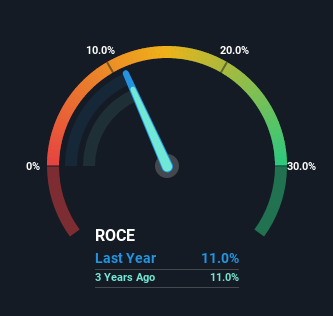There Are Reasons To Feel Uneasy About Indian Terrain Fashions' (NSE:INDTERRAIN) Returns On Capital
If we want to find a potential multi-bagger, often there are underlying trends that can provide clues. One common approach is to try and find a company with returns on capital employed (ROCE) that are increasing, in conjunction with a growing amount of capital employed. Ultimately, this demonstrates that it's a business that is reinvesting profits at increasing rates of return. However, after briefly looking over the numbers, we don't think Indian Terrain Fashions (NSE:INDTERRAIN) has the makings of a multi-bagger going forward, but let's have a look at why that may be.
What Is Return On Capital Employed (ROCE)?
Just to clarify if you're unsure, ROCE is a metric for evaluating how much pre-tax income (in percentage terms) a company earns on the capital invested in its business. Analysts use this formula to calculate it for Indian Terrain Fashions:
Return on Capital Employed = Earnings Before Interest and Tax (EBIT) ÷ (Total Assets - Current Liabilities)
0.11 = ₹316m ÷ (₹5.5b - ₹2.6b) (Based on the trailing twelve months to December 2022).
Thus, Indian Terrain Fashions has an ROCE of 11%. In absolute terms, that's a pretty normal return, and it's somewhat close to the Luxury industry average of 12%.
See our latest analysis for Indian Terrain Fashions

Historical performance is a great place to start when researching a stock so above you can see the gauge for Indian Terrain Fashions' ROCE against it's prior returns. If you'd like to look at how Indian Terrain Fashions has performed in the past in other metrics, you can view this free graph of past earnings, revenue and cash flow.
The Trend Of ROCE
When we looked at the ROCE trend at Indian Terrain Fashions, we didn't gain much confidence. To be more specific, ROCE has fallen from 23% over the last five years. However, given capital employed and revenue have both increased it appears that the business is currently pursuing growth, at the consequence of short term returns. If these investments prove successful, this can bode very well for long term stock performance.
On a side note, Indian Terrain Fashions' current liabilities have increased over the last five years to 48% of total assets, effectively distorting the ROCE to some degree. If current liabilities hadn't increased as much as they did, the ROCE could actually be even lower. What this means is that in reality, a rather large portion of the business is being funded by the likes of the company's suppliers or short-term creditors, which can bring some risks of its own.
In Conclusion...
Even though returns on capital have fallen in the short term, we find it promising that revenue and capital employed have both increased for Indian Terrain Fashions. But since the stock has dived 74% in the last five years, there could be other drivers that are influencing the business' outlook. Therefore, we'd suggest researching the stock further to uncover more about the business.
Since virtually every company faces some risks, it's worth knowing what they are, and we've spotted 5 warning signs for Indian Terrain Fashions (of which 1 is concerning!) that you should know about.
For those who like to invest in solid companies, check out this free list of companies with solid balance sheets and high returns on equity.
New: AI Stock Screener & Alerts
Our new AI Stock Screener scans the market every day to uncover opportunities.
• Dividend Powerhouses (3%+ Yield)
• Undervalued Small Caps with Insider Buying
• High growth Tech and AI Companies
Or build your own from over 50 metrics.
Have feedback on this article? Concerned about the content? Get in touch with us directly. Alternatively, email editorial-team (at) simplywallst.com.
This article by Simply Wall St is general in nature. We provide commentary based on historical data and analyst forecasts only using an unbiased methodology and our articles are not intended to be financial advice. It does not constitute a recommendation to buy or sell any stock, and does not take account of your objectives, or your financial situation. We aim to bring you long-term focused analysis driven by fundamental data. Note that our analysis may not factor in the latest price-sensitive company announcements or qualitative material. Simply Wall St has no position in any stocks mentioned.
About NSEI:INDTERRAIN
Indian Terrain Fashions
Engages in the retail of branded apparel in India.
Mediocre balance sheet and slightly overvalued.
Similar Companies
Market Insights
Community Narratives



